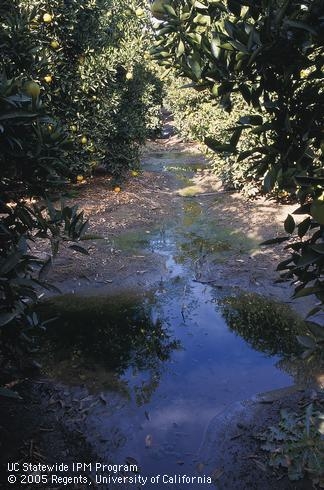Maintenance of Microirrigation Systems
Microirrigation systems include microsprinklers for tree crops, drip emitters for trees, vines, and some row crops, and drip tape for row and field crops. Microirrigation systems apply water to the soil through emitters that are installed along drip lines and contain very small flow passages. Microirrigation systems can apply water and fertilizers more uniformly than other irrigation methods. This uniformity results in potentially higher yields, higher revenue, and reduced irrigation operating costs.
Uniformity, a performance characteristic of irrigation systems, is a measure of the evenness of the applied water throughout the irrigation system. Distribution uniformity (DU), sometimes called emission uniformity (EU), is an index that describes how evenly or uniformly water is applied throughout the field. A uniformity of 100% means the same amount of water was applied everywhere. Unfortunately, all irrigation systems apply water at a uniformity of less than 100%, and thus some parts of a field receive more water than others. Field evaluations have shown that microirrigation systems have the potential for higher uniformity than other irrigation methods. However, clogging reduces the uniformity of applied water in microirrigation systems, thus increasing the relative differences in applied water throughout a field.
The small flow passages in the emitters and microsprinklers make microirrigation systems highly susceptible to clogging. Clogging reduces the uniformity of the applied water and decreases the amount of applied water. Clogging also decreases the amount of salt leaching around the lateral line in saline soils.
The objective of this web site is to provide information to irrigators about the causes of clogging and the methods for preventing or correcting clogging problems in microirrigation systems. Among the topics covered are the sources of clogging, chlorination, preventing chemical precipitation, filtration, flushing, and monitoring microirrigation systems.
This web site is divided into sections to allow the users to more quickly access the information they want. For example, if you already know you have a clogging problem and you want to solve it, go to the section Solutions to Existing Clogging Problems - "I have a problem and I want to solve it".
Attached Images:
